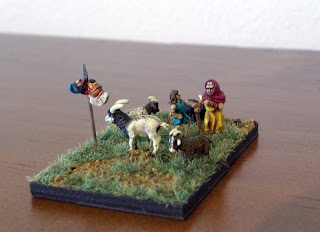 |
| Antiochos VIII Grypos (Hooknose) 125-96 BC |
As most DBA players would be aware, evolving lists have been posted and made available through Fanaticus (HERE somewhere) for some time now. Back in July, I caught on to this and had a look at the Seleukid list (II/19) to see what changes had occurred and was relatively pleased with some things, rather concerned by others. I shot off the following email to Sue Laflin-Barker at WRG:
Dear Sue,
Apologies for not being in touch sooner. I have been snowed under with work (and fatherhood) over the last six months and have only just seen the suggested DBA 3.0 army lists. I have a couple of comments or suggestions for the Seleukid lists (II/19) that I feel qualified to make.
i) While I'm glad to see the Seleukid list finally being continued dow to the date of Pompey's dissolution of the Sleukid kingdom, the event happened in 64 BC, not 69 BC.
ii) Sekunda's volume on the Seleukid army is very flawed and not regarded very highly among academics. I was very surprised not to see Bar-Kochva's The Seleucid army: organization and tactics in the great campaigns <http://www.amazon.com/Seleucid-Army-Organization-Campaigns-Cambridge/dp/0521206677> which is a much better researched monograph and also looks into order of battles etc.
iii) Army list d should either be dater 166-64 BC or 166-96 BC allowing for an e list (96-64 BC). A realistic e list would look something like 1xKn (Gen), 1xLH, 1xBd, 2xPk, 2x (Pk or Ax), 2xAx, 1x (Cm or Ps), 2xPs reflecting the shrinking kingdom, less access to eastern cavalry, more reliance on civic militia or Levanine levies (Ax and Cm), certainly no El.
iv) Army list d enemies should include II/22d Characene (fought against by Demetrios II and Antiochos VII, II/28a Tigranes (since Hoover's article in Historia, 2007, it has been clear that Tigranes invasion of Syria should be dated c.75 BC and had an agressive, militaristic side - he was not invited in due to lack of Seleukid kings). II/33 Polybian Romans are a slightly ahistorical opponent. There was no armed conflict between Rome and the Seleukids after 187 BC.
v) Army list d allies, I am positive that II/47 Early Germans are a mistake...
Please, take these points as you will. I would hope to see points i and v taken into account at the very least.
Best,
Nic
Her response was a little underwhelming:
Thank you for the comments. I'll certainly add the Bar-Kochva reference.
Sue
I have just had another look at the most recent lists and have seen that alot more was taken on board than I had originally feared.
All points i, ii, and the first option of iii, iv and v were all accepted. All there in the new list. I now query why II2 and II3 (Indian armies) are listed as opponents for such a late Seleukid army (166-64 BC)...
I know that WRG have taken a lot of recent flak for not engaging with the wider DBA community or listening to the opinions of those outside of their immediate testing circle. In this case though, I was really pleased to see some changes accepted.
On the whole, bravo to Sue!







































